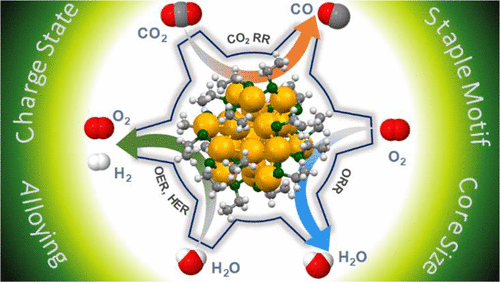当前位置:
X-MOL 学术
›
Chem. Mater.
›
论文详情
Our official English website, www.x-mol.net, welcomes your
feedback! (Note: you will need to create a separate account there.)
Gold Nanoclusters as Electrocatalysts: Atomic Level Understanding from Fundamentals to Applications
Chemistry of Materials ( IF 7.2 ) Pub Date : 2021-08-06 , DOI: 10.1021/acs.chemmater.1c02112 Malenahalli H. Naveen 1 , Rizwan Khan 2 , Jin Ho Bang 1, 3, 4
Chemistry of Materials ( IF 7.2 ) Pub Date : 2021-08-06 , DOI: 10.1021/acs.chemmater.1c02112 Malenahalli H. Naveen 1 , Rizwan Khan 2 , Jin Ho Bang 1, 3, 4
Affiliation

|
Recently, gold nanoclusters (Au NCs) have become more popular as their structure–property relationships start to rival those of conventional Au NPs. The molecular-type energy transition and quantum confinement effects of Au NCs are fundamentally different from those of Au NPs. Because of these intriguing features, Au NCs are gaining special attention in catalysis research and are being used as model catalysts to understand catalytic properties and structures at the atomic level. Although catalysis research is a longstanding discipline, the fundamental insights into structure–property relationships at the atomic level, such as reaction mechanism/activation at the catalyst surface and identification of actives sites, remain largely unexplored. Atomically precise Au NCs can provide access to such information because of their exact molecular information, monodisperse nature, molecule-like properties, and well-resolved atomic structure from X-ray crystallography, akin to protein structures in enzyme-based catalysis. This accurate data also provides essential information for computational investigations. In this Perspective, we summarize the recent progress made using Au NCs as electrocatalytic materials for oxygen reduction, water electrocatalysis, and electrochemical reduction of carbon dioxide, and we discuss challenges to overcome existing limitations. We hope that our Perspective motivates more researchers to investigate different aspects of Au NCs toward a better understanding of the structure–performance correlations in catalysis.
中文翻译:

金纳米团簇作为电催化剂:从基础到应用的原子级理解
最近,金纳米团簇(Au NCs)变得越来越流行,因为它们的结构-性能关系开始与传统的 Au NPs 相媲美。Au NCs的分子型能量跃迁和量子限制效应与Au NPs有着根本的不同。由于这些有趣的特性,Au NCs 在催化研究中受到了特别的关注,并被用作模型催化剂以在原子水平上了解催化性质和结构。尽管催化研究是一门长期存在的学科,但在原子水平上对结构-性质关系的基本见解,例如催化剂表面的反应机制/活化和活性位点的识别,在很大程度上仍未得到探索。原子精确的 Au NC 可以提供对此类信息的访问,因为它们具有精确的分子信息、单分散性、类分子特性以及 X 射线晶体学中解析良好的原子结构,类似于基于酶的催化中的蛋白质结构。这些准确的数据还为计算研究提供了必要的信息。在这个观点中,我们总结了使用 Au NCs 作为电催化材料进行氧还原、水电催化和二氧化碳电化学还原的最新进展,并讨论了克服现有局限性的挑战。我们希望我们的观点激励更多的研究人员研究 Au NC 的不同方面,以更好地理解催化中的结构-性能相关性。以及来自 X 射线晶体学的解析良好的原子结构,类似于基于酶的催化中的蛋白质结构。这些准确的数据还为计算研究提供了必要的信息。在这个观点中,我们总结了使用 Au NCs 作为电催化材料进行氧还原、水电催化和二氧化碳电化学还原的最新进展,并讨论了克服现有局限性的挑战。我们希望我们的观点激励更多的研究人员研究 Au NC 的不同方面,以更好地理解催化中的结构-性能相关性。以及来自 X 射线晶体学的解析良好的原子结构,类似于基于酶的催化中的蛋白质结构。这些准确的数据还为计算研究提供了必要的信息。在这个观点中,我们总结了使用 Au NCs 作为电催化材料进行氧还原、水电催化和二氧化碳电化学还原的最新进展,并讨论了克服现有局限性的挑战。我们希望我们的观点激励更多的研究人员研究 Au NC 的不同方面,以更好地理解催化中的结构-性能相关性。在这个观点中,我们总结了使用 Au NCs 作为电催化材料进行氧还原、水电催化和二氧化碳电化学还原的最新进展,并讨论了克服现有局限性的挑战。我们希望我们的观点激励更多的研究人员研究 Au NC 的不同方面,以更好地理解催化中的结构-性能相关性。在这个观点中,我们总结了使用 Au NCs 作为电催化材料进行氧还原、水电催化和二氧化碳电化学还原的最新进展,并讨论了克服现有局限性的挑战。我们希望我们的观点激励更多的研究人员研究 Au NC 的不同方面,以更好地理解催化中的结构-性能相关性。
更新日期:2021-10-12
中文翻译:

金纳米团簇作为电催化剂:从基础到应用的原子级理解
最近,金纳米团簇(Au NCs)变得越来越流行,因为它们的结构-性能关系开始与传统的 Au NPs 相媲美。Au NCs的分子型能量跃迁和量子限制效应与Au NPs有着根本的不同。由于这些有趣的特性,Au NCs 在催化研究中受到了特别的关注,并被用作模型催化剂以在原子水平上了解催化性质和结构。尽管催化研究是一门长期存在的学科,但在原子水平上对结构-性质关系的基本见解,例如催化剂表面的反应机制/活化和活性位点的识别,在很大程度上仍未得到探索。原子精确的 Au NC 可以提供对此类信息的访问,因为它们具有精确的分子信息、单分散性、类分子特性以及 X 射线晶体学中解析良好的原子结构,类似于基于酶的催化中的蛋白质结构。这些准确的数据还为计算研究提供了必要的信息。在这个观点中,我们总结了使用 Au NCs 作为电催化材料进行氧还原、水电催化和二氧化碳电化学还原的最新进展,并讨论了克服现有局限性的挑战。我们希望我们的观点激励更多的研究人员研究 Au NC 的不同方面,以更好地理解催化中的结构-性能相关性。以及来自 X 射线晶体学的解析良好的原子结构,类似于基于酶的催化中的蛋白质结构。这些准确的数据还为计算研究提供了必要的信息。在这个观点中,我们总结了使用 Au NCs 作为电催化材料进行氧还原、水电催化和二氧化碳电化学还原的最新进展,并讨论了克服现有局限性的挑战。我们希望我们的观点激励更多的研究人员研究 Au NC 的不同方面,以更好地理解催化中的结构-性能相关性。以及来自 X 射线晶体学的解析良好的原子结构,类似于基于酶的催化中的蛋白质结构。这些准确的数据还为计算研究提供了必要的信息。在这个观点中,我们总结了使用 Au NCs 作为电催化材料进行氧还原、水电催化和二氧化碳电化学还原的最新进展,并讨论了克服现有局限性的挑战。我们希望我们的观点激励更多的研究人员研究 Au NC 的不同方面,以更好地理解催化中的结构-性能相关性。在这个观点中,我们总结了使用 Au NCs 作为电催化材料进行氧还原、水电催化和二氧化碳电化学还原的最新进展,并讨论了克服现有局限性的挑战。我们希望我们的观点激励更多的研究人员研究 Au NC 的不同方面,以更好地理解催化中的结构-性能相关性。在这个观点中,我们总结了使用 Au NCs 作为电催化材料进行氧还原、水电催化和二氧化碳电化学还原的最新进展,并讨论了克服现有局限性的挑战。我们希望我们的观点激励更多的研究人员研究 Au NC 的不同方面,以更好地理解催化中的结构-性能相关性。











































 京公网安备 11010802027423号
京公网安备 11010802027423号